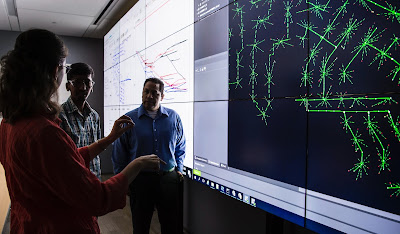Brief Introduction to Supply Chain & Effects of COVID-19 on Supply Chain
Recently, we have been hearing a lot about Supply Chain. Everybody in Newspapers, TV and the Internet is talking about Supply Chain saying effective design and utilization of the Supply Chain is crucial to survive these hard times of COVID-19 and uplift the economy. So, what exactly is Supply Chain?

Many people think Supply Chain and Logistics or Inventory Management are the same and they can be used interchangeably. However, they are completely different concepts and they should not be used like that. In truth, Inventory Management and Logistics are just one of the processes or one component of a chain in Supply Chain. I’ll try to clarify these concepts. Also, a brief discussion on uncertainties in Supply Chain in the context of Nepal and the current situation of Supply Chain around the globe is presented.
What is Supply Chain?
Most of the things we have around us comes as a part of a supply chain. In simple words, a series of procedures linked together which form a chain and acts as a unit is known as supply chain. Planning, controlling and executing these procedures referred to as Supply Chain Management (SCM). Is it that simple?
 |
| Interlink between the components can be imagined something like Garden by the Bay, Singapore. |
Supply chain includes all the activities in any organization, from gathering raw materials or parts, transforming them to finished goods and adding value to them. It also includes the distribution and promotion of these goods to retailers or directly to the customers; and helps to exchange information between all the entities of supply chain (Akbari & Karimi, 2015).
Examples of supply chain activities include farming, refining, design, manufacturing, packaging, etc. you name it, you’ll find supply chain in every sector.One general example of Supply Chain is: A farmer gets the seeds (raw materials) to plant crops (rice). After harvesting, he sells his products to the processing plant or manufacturing plant to convert it into the final product. Processing/Production plant distributes the final goods through various distribution channels like by road, train, flight. It is delivered to the retail store and from the retail store; we can buy the final product (rice).

The above example is a very simple or linear supply chain. We can increase the complexity of this supply chain by adding a few suppliers, few farmers, few distributions centers and few customer zones. The complexity of the supply chain increases drastically with these additions. But don’t worry, we won't dive that deep. We’ll scratch the surface of most of the processes of the Supply Chain.
Forecast/Demand Planning - In other words, customer needs. A forecast is a prediction of demand by using various models using historical data. It helps us determine type and quantities.
Production Planning – Planning of production and manufacturing modules. Generally, determining the required product mix and factory load, matching the required level of production to the existing resources, Scheduling and Setting up and delivering production orders to production facilities.
MRP/MRPII/ERP - Resource planning ( First came MRP around ‘60s then MRP II then ERP). This ensures there is a sufficient supply of materials and components required for production. On-hand inventory, possible shortage and lead-time for the materials are all considered here. Most of Business units (BUs) are included in ERP which is the evolved version.
Inventory Management and Logistics - (*** This is just to remind you what I discussed earlier) Managing raw materials, Work in progress or finished goods so that there is no shortage anywhere throughout the chain is the main purpose of Inventory Management. Right goods, at the right level, in the right place and at the right cost means Inventory Management.
Logistics - is just transporting and storing goods (raw materials, Work in progress and finished goods) from start to end of the chain and used around the supply chain cycle.
Procurement – Finding suppliers. Locating a good supplier is crucial for success. Therefore, this process is all about finding and maintaining a good relationship with suppliers economically.
Order fulfillment and Customer Service -
Contracts and Outsourcing -
These are the few most basics processes. Each process has a single book dedicated to it. Here, I have provided a general introduction of the terms.

Supply Chain Management in simple words is just managing supply chain processes; it is the management of the flow of goods and services and includes all processes that transform raw materials into final products. It makes sure the flow of goods, information and capital is optimized. This can be achieved by using business strategies and specialized software dedicated to each step of Supply Chain processes.
Types of Supply Chain Network
There are mainly three types of supply chain networks: forward (conventional), reverse logistics and closed-loop supply chain. A supply chain which focuses on the flow of product only in one direction, i.e., conversion of raw material to finished products known as conventional or forward supply chain (Wang & Hsu, 2010) (Özceylan & Paksoy, 2013). Reverse logistics is collecting and recovering returned products (Melo et al. 2009) (Diabat et al. 2015). A supply chain design that considers the combination of forward and reverse simultaneously is known as closed-loop supply chain design (Das & Posinasetti, 2015) (Tsao et al. 2017).

A conventional or forward supply chain is the one that is used by most of the organizations. But with changing time, people are thinking about the Closed-loop supply chain which addresses the big issue of environmental risks. In fact, in Japan every company is responsible for the product even after their end of life, which contributes significantly to protect the environment. The closed-loop supply chain is the future and every other nation can follow Japan’s lead on this.
Next, let’ see the benefits of the Supply Chain. Moreover, why everyone is talking about it?
- SCM allows us to visualize the bigger picture, giving a better understanding of the flow of materials and information. They reveal the links between associations and stream of information and matter between the links.
- A good design of the supply chain can reduce the total cost of the supply chain and it has been found that 80% of supply chain costs are determined by the location of facilities and the stream of product between different facilities (Watson et al., 2013).
- Organizations can run SCM scenarios, asses and proactively execute changes in response to dynamic scenarios like a product launch, demand pattern changes, changes in taxation laws and so on to achieve competitive advantage (Balaji & Kumar, 2013).
- SCM helps to evaluate company policies and agendas and reach targets to achieve long-term strategic objectives.
- Perhaps lesser-known and underappreciated is SCM's critical role in society. SCM can help ensure human survival by improving healthcare, protecting people from climate extremes and sustaining life. People rely on supply chains to deliver necessities like food and water as well as medicines and healthcare. The supply chain is also vital to the delivery of electricity to homes and businesses, providing the energy needed for light, heat, air conditioning and refrigeration.
- SCM can also improve quality of life by fostering job creation, providing a foundation for economic growth and improving standards of living. It provides a multitude of job opportunities, since supply chain professionals design and control all of the supply chains in a society as well as manage inventory control, warehousing, packaging, and logistics.
- Furthermore, a common feature of most poor nations is their lack of developed supply chains. Societies with strong, developed supply chain infrastructures -- such as large railroad networks, interstate highway systems and an array of airports and seaports -- can efficiently exchange goods at lower costs, allowing consumers to buy more products, thus providing economic growth and increasing the standard of living (Rouse, 2019).
The maturity of supply chain clearly shows the status/standing of any company or a country.
The life cycle of the products is getting shorter day by day because of the competitive global market, rapid improvement in information technology and varying customer expectations. To cope with this more dynamic and responsive supply chain is required. It also helps to better prepare for the unseen future by making respective changes.
Uncertainties in Supply Chain
Compromising in the supply chain’s objectives because of uncertain parameters in supply chain features due to unwanted events can be defined as supply chain risk (Heckmann et al 2015). Parameters like demand, costs and supply are uncertain in nature while designing a supply chain network are considered operational risks and natural or man-made disasters that cause major disruption are known as disruption risks (Tang, 2006).
Supply chain disruption is an event that may occur in a part of SC due to natural disasters or through intentional or unintentional human actions which will have undesired effects on SC’s goal and performance.
The disruption risks evoked by SC disruptions can affect the functionality of SC’s elements completely or partially for uncertain time duration (Govindan et al., 2017).
Today’s supply chains are more than ever, under threat of disruptions due to sophisticated trends and strategies such as globalization, outsourcing, just-in-time deliveries and lean practices (Jabbarzadehab et al., 2016). Common causes of supply chain disruption include natural disasters, production problems, accidents, labor availability, terrorist attacks, unexpected and sudden shocks, economic crisis, and war (Jabbarzadehab et al. 2018). Attack on September 11th, 2001 on WTC and the pentagon, hurricane Katrina in 2005, earthquakes in Chile, Japan 2011 and Nepal 2015 are few examples of the events that can cause disruption and the effect of these events is very devastating.
COVID-19 is the recent addition to this list of disruptions. It is practically impossible to realize the impact it will have on globalization and global supply chains for years to come.

Supply chain is suffering now and it will continue to get worse if immediate action with a proper plan is not carried out. People were suffering at that time of earthquake and people might suffer even more if strategies and plans for effective and efficient supply chains are not modeled in time.
How was the Supply Chain affected during and after the earthquake of April 2015?
During this disaster, even humanitarian experts of supply chain were facing difficulty because of the geography and the mountains, terrains, poor road and other infrastructure. Incomplete transportation networks, security problems and limited reliable information were other reasons behind this. The consequences were delivery delays, insufficient capacity, market fluctuations, lack of resources/skilled workforce, high demand and insufficiency in the market, etc. to name a few. One of the real reason was because of deceptive information or lack of useful information.
While the whole world has recognized the power of information and have been using it for their advantage. We still don’t have a reliable and functioning centralized database that can be used during crisis management. In information age: Knowledge is power, data is money. However, we are still unaware of it.

It was concluded that there was no prior knowledge or experience regarding risk mitigation. Government/policymakers were devoting much effort and energy to disruption (the outcome of the risks) instead of investing in mitigation (Baharmand, Comes, & Lauras, 2015).
I expect our policymaker/government have understood or at least have an idea about goods that are critical to maintaining health and safety during the crisis. We can only hope that we have improved and strengthened our supply chain capabilities for the next shock (COVID-19). I am confident that five years is more than enough for government/policymakers to come up with some kind of plan for this dire situation. (Am I expecting too much from our policymakers/government?)
How is the situation due to COVID-19? (In Nepal)
Year 2020 was announced as “Tourism Year” and the outbreak of COVID-19 started in December 2019 in China. China is mainly known as a global supplier of goods but people forget about Chinese tourists. Last decade or so the number of Chinese tourists visiting the globe has increased significantly. Nepal has already suffered a huge blow in the Tourism Industry. It was anticipating the highest number of visitors in its’ history. Travel, tourism and hospitality sectors have been badly affected and it will continue to get worse for a year or so. Even domestic tourism is suffering/will suffer for a year because of a lack of jobs and lack of remittance. People cannot travel without money so the impact is evident. The only hope for this sector is government plans and policies. This might be their only tool for survival.

Remittance is already record low and it will continue to decrease. The economic crisis will result in global unemployment. Oil companies have decreased production and they will or they already have started reducing staff. Nepal economy depends hugely on remittance. During the earthquake 2015, Nepal was the only country affected so it didn’t drop the remittance but this situation is completely different.
The whole world is affected so great vision and proper plan from policymakers/government is necessary to sustain the country. Business failures, rising unemployment and falling revenues are other important concerns.
Short-term solutions should be complete focus on the supply chain of essentials, promoting domestic production, tax relief and subsidies, controlling the market and rescheduling loans slashing duty on raw materials (when the situation is normal).
How is the situation due to COVID-19? (Around the globe)
Recently, 22 million people have lost their jobs in the US and it’s only one country. According to UN ILOs report, it is estimated that 195 million people will lose their jobs. Unemployment is just one result of COVID-19 but it is a serious one because it leads to hunger and hunger leads to death. Severe shortages and price hike have become the norm. Most countries are in crisis management mode assessing impacts and responses daily. Managing workforce, products, and costs has been a great challenge to organizations all over the world.
“Don’t put all your eggs in one basket”
Disruption in one corner of the world could starve the entire chain from much-needed inputs because of globalization. Supply Chains of most of the organizations have been affected significantly because most of the companies rely on China for raw materials, parts, and final products. China has established itself as a global supplier. At first, because of cheap labor, now, with the crisp and advanced manufacturing technology. China is not just a supplier but an importer too. Nepal exports carpets, herbs and many other things to China, which has stopped because of COVID-19.
Most of the manufacturing industries are closed because in these times businesses must respond on multiple fronts at once: at the same time that they work to protect their worker’s safety, they must also safeguard operational viability, now increasingly under strain from a historic supply chain-shock. Variability in the market has hit smaller businesses very hard.
Solutions?
Disruption can be fatal to any organization/country since it causes huge loss of infrastructure, money and market. Whenever there is disruption, all the costs associated increases. In most of the cases, disruptions are unavoidable but the effect of it can be minimized.
Few recent examples of disruptions are: Thailand’s 2011 floods affected the supply chains of computer manufacturers dependent on hard disk and Japanese auto companies with plants in Thailand. Air shipments and millions of passengers were greatly affected because of the eruption of the volcano in Iceland in 2010 (Chopra & Sodhi, 2014). Only certain area/region or country was affected by those disruptions but with COVID-19, the whole world is disrupted claiming thousands of human life.

Centralized procurement strategy, better inventory control, transparency on multitier supply chains, assessment of customer demand and response to shortage buying, optimization of production and distribution capacity ensuring employees safety, identifying and securing logistic capacity, estimating and accelerating logistics, managing cash and net working capital by running stress test and diversifying supply bases are more realistic short term solutions.
This is a new territory for the country, industries, and economy caused by globalization and supply chain disruption. Data sets and forecasting tools will be crucial to make strategic decisions in these unpredictable times. Being aware of the risks should help in formulating corporate strategies and business planning. It’s time to turn “crisis management” to “risk management” quickly without a delay.

One way is by planning for disruptions in the design phase of the supply chain. Long-term or the ultimate solution is designing a flexible supply chain network considering the risks. Supply chain network design is the most basic decision of supply chain management, which affects all other decisions and has the most extensive effect on the chain’s return on investment and its overall performance (Simchi-Levi et al. 2004).
Country/Company efficiency and effectiveness are significantly affected by supply chain network design; therefore, designing of a supply chain network is a very important work (Zokaee et al. 2017).
Main planning decisions include location-allocation, production, inventory, capacity decision for supply chain facilities, technology selection, transportation mode’s decisions, supplier selection for raw materials/components, selection of transportation links, routing decisions, supplier selection for finished products, capacity decisions for transportation links and price decisions (Govindan et al. 2017). SCN is not static and has to evolve with time to survive. Versatility of supply chain to deal with future uncertainties is one of the key parts of designing the supply chain network (Klibi & Martel, 2012b).

Supply Chain mapping is another tool that is very useful for a time like this but it is resource-intensive and difficult. Digitizing supply chain management improves the speed, accuracy and flexibility of supply risk management. Scenario analysis can be used to review the resiliency of nodes which can reveal weakness even the individual component may appear resilient.
Number-one priority should be for goods that are critical to maintaining health and safety during the crisis. As the coronavirus pandemic subsides, the tasks will center on improving and strengthening supply-chain capabilities to prepare for the inevitable next shock. By acting intentionally today and over the next several months, companies and governments can emerge from this crisis better prepared for the next one (Alicke, Azcue, & Barriball, 2020).
We should be safe if the government/policymakers have made any plans or strategic decisions after the earthquake and blockade in 2015. But the question is, have they? Did we learn anything or was it all-vain?
The current condition of daily wage workers and people around the country tells a different story. No plans, no policies and implementation rate is non-existent from the government.
Something to hope for
With proper support from the government and passionate people who want to contribute something to the country, we can survive and thrive through this crisis. Meticulous planning, immediate action, a little bit of love for people and hope is more than enough to overcome this. At times like this, all we can do is stand together with our country, wait for the government/policymakers to come up with a plan.
As Franklin D. Roosevelt said, “A smooth sea never made a skilled sailor”. Likewise, “Easy times won’t make a great leader” so this is a challenge for the leaders around the world to be great or despised throughout history.
Related Articles: Corruption in Nepal: Corruption : Effects, Causes and Remedies, Agriculture Supply Chain (Nepal), MCC Nepal, Impact of COVID-19 on Sports (Football) Industry., Lockdown Stories, Challenges of Nepal Government in Corona Era .
Thank you for your visit. I hope everything was clear, if not please do not hesitate to contact me for suggestions or queries regarding this topic. Honest feedback is highly appreciated. You can contact me via “ashishworks2020@gmail.com “. Thanks again.
References
Akbari, A. A., & Karimi, B. (2015). A new robust optimization approach for integrated multi-echelon, multi-product, multi-period supply chain network design under uncertainty. International Journal of Advanced Manufacturing Technology, 229-244.
Alicke, K., Azcue, X., & Barriball, E. (2020). Supply-chain recovery in coronavirus times—plan for now and the future. Retrieved from McKinsey & Company Operations: https://www.mckinsey.com/business-functions/operations/our-insights/supply-chain-recovery-in-coronavirus-times-plan-for-now-and-the-future
Baharmand, H., Comes, T., & Lauras, M. (2015). Mitigating transportation risks at humanitarian supply chains: insights from the 2015 Nepal earthquake. University of Integrated Emergency Management.
Balaji, L., & Kumar, S. (2013, July 8). Supply chain - Planning and Forecasting. Retrieved from IndustryWeek: https://www.industryweek.com/planning-amp-forecasting/how-reduce-costs-through-supply-chain-network-optimization
Chopra, S., & Sodhi, M. S. (2014, March 18). Reducing the Risk of Supply Chain Disruptions. Retrieved from MIT Sloan Management Review: https://sloanreview.mit.edu/article/reducing-the-risk-of-supply-chain-disruptions/
Das, K., & Posinasetti, N. R. (2015). Addressing environmental concerns in closed-loop supply chain design and planning. International Journal of Production Economics, 34-47.
Forrest, M. (2017, November 9). Carto. Retrieved from What is Supply Chain Network Design and How Does It Work?: https://carto.com/blog/what-is-supply-chain-network-design-how-does-it-work/
Klibi, W., & Martel, A. (2012b). Scenario-based Supply Chain Network risk modeling. European Journal of Operational Research, 644-658.
Odwlogistics. (2016, September 26). Blog Supply chain network design. Retrieved from ODW Logistics: https://blog.odwlogistics.com/blog/supply-chain-network-design
Özceylan, E., & Paksoy, T. (2013). Interactive fuzzy programming approaches to the strategic and tactical planning of a closed-loop supply chain under uncertainty. International Journal of Production Research, 2363-2387.
Rouse, M. (2019). SearchERP. Retrieved from Supply Chain Management: https://searcherp.techtarget.com/definition/supply-chain-management-SCM
Shen, Z.-J. M., & Qi, L. (2007). Incorporating inventory and routing costs in strategic location models. European Journal of Operational Research, 372-389.
Tang, C. S. (2006). Internation Journal of Production Economics. Perspectives in supply chain risk management, 451-488.
Wang, H.-F., & Hsu, H.-W. (2010). A closed-loop logistic model with a spanning-tree based genetic algorithm. Computer & Operations Research, 376-389.













Interesting and Informative read.
ReplyDeleteGlad that you liked it. Thank you!
Deletegreat initation Ashish, supply chain is indeed a burning topic as country faces irregularity in providing basic goods and services to their citizens; a strong dedicated plan is what required. In such epidemic, money may not be able to buy eveything, but appropirate supply chain could ease situation not to get worst.
ReplyDeleteNicely said, Puskar ! Yes, "Prevention is always better than cure". Carefully designed supply chain will serve for years to come. Thank you for summarizing it brilliantly !
DeleteReally nice man. Interesting stuff. Please increase the default font size if i'm not mistaken. Good Luck!
ReplyDeleteThank you for your feedback bro ! Definitely, I will do so!
DeleteHope the font size with this one is okay?https://ashishdevkota2020.blogspot.com/2020/04/impactofcovidonfootball.html .
Really appreciate it bro. Thanks again ! :)
Insightful. I recommend you to publish this article in daily newspaper for it to be more impactful. More people need to know about the SCM.
ReplyDeleteThank you very much for your suggestion ! :)
Delete